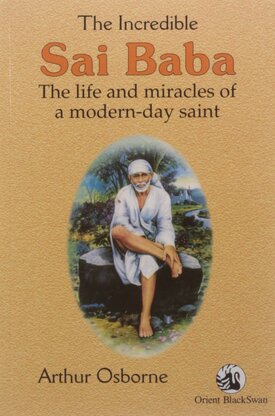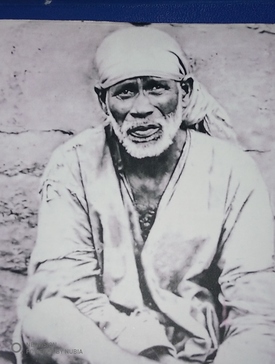The Incredible Sai Baba
by Arthur Osborne


Revised edition 1972
© 1957 – Orient Longmans Private, Ltd, Calcutta
Table of Contents
page
7 Foreword
11 Introducing Sai Baba
37 The Guru and His Family
68 Hinduism and Islam
68 Symbols and Powers
91 The Symbolism of Money
103 Upadesa
118 Death and Survival
Foreword
It is perfectly true, as the author remarks, that Sri Sai Baba, although well known all over India, is not known outside India, especially in the Western countries. The author wishes to introduce him to the Western world. With this laudable object in view he has written this book which contains Sri Sai Baba’s brief life, teachings, miracles and anecdotes. Although Sai Baba’s life, as depicted in the book based on authentic reports of his devotees, is strange and eccentric, no one who has come in contact with him and his devotees can deny the fact that he was, and Ramdas can say he is, a saint of the highest spiritual eminence.
Ramdas had the privilege of visiting Shirdi about four years ago for the darshan of Baba’s samadhi. He found that the atmosphere in the Mandir where the samadhi is located was vibrating with spiritual peace and Joy. Sai Baba seems to be still living in that holy place. Another wonderful sight that met Ramdas’s eyes was that a regular stream of devotees was pouring into the temple for the darshan of Baba’s samadhi throughout the day. In Ramdas’s wanderings in different parts of India and during his visits to the houses of devotees he also discovered everywhere pictures of Sai Baba adorning the walls. His popularity is so vast and wide that his name has become almost a household word among the people of India, who hold him in the highest veneration. Sai Baba is a most potent spiritual force that moulds and transforms the life of spiritual aspirants who seek his guidance and blessings even to this day.
The author, Arthur Osborne, has done an invaluable service to the seekers of Truth in the West by presenting this book to the world. He-has, in a spirit of love and devotion to Sai Baba, related the most important events in his life which stand out in bold perspective, conveying to the heart of the reader the pre-eminent glory of Sai Baba. Sai Baba’s divine personality seems to have captured the heart of the author and he writes about him with such a spontaneity, giving details of the life and miracles culled from various sources, that he cannot but create in the heart of the reader a wave of admiration and devotion for this great spiritual master.
Ramdas earnestly wishes that this book should be in the hands of every spiritual aspirant and, for that matter, everyone, whether he is a believer or non-believer, so that he can know how God reveals Himself in the form of a unique and fully inspired saint of Sai Baba’s stature. Sai Baba’s sayings are quite original in their import and expression. The last quotation from Baba’s sayings, as mentioned in this book, has charmed Ramdas and he will end this short foreword by giving it here: ‘I give people what they want in the hope that they will begin to want what I want to give them.’
Introducing....
Look, here comes the crazy fakir again!”
The shopkeepers turned and looked up the street at the tall, gaunt youth who was striding towards them, energetic but aloof, speaking to nobody.
No one knew who he was. He had first appeared in the little town of Shirdi as a lad of about sixteen in 1872, as wandering fakirs do, none knowing whence or why. He wandered away again, roamed about for a while, and then came back and spent the rest of his life there. During his earlier visits he lived under a neem-tree, sitting there in the daytime, sleeping on the bare ground at night, eating what little food the charitable townsfolk gave him. When he stopped wandering and settled down at Shirdi, he went first to a little Hindu temple there, intending to make it his abode; but the custodian, Mahalsapathy, who later became one of his closest disciples, regarded him as a uslim fakir and refused him admission, bidding him go to the mosque to live. He did so, and the little mud-walled mosque remained his home.
He spoke with the holy men, Hindu or Muslim who occasionally passed through the town, and one of them had told the townsfolk: “Watch that young fakir; he’s a jewel on a dunghill.”
But they had not taken much notice. It seemed more likely to them that he was a bit cracked. He did not mix with them — scarcely spoke. He sometimes said namaz (the ritualistic Islamic prayer that has to be said five times a day), but very seldom. He had queer habits of his own too — he kept a fire burning perpetually in the little mosque — more like a Parsi than Muslim — and he burned little oil lamps there.
Except for a handful of food, oil for the lamps was the only thing he needed and he used to go to the shop-keepers to beg it. That was what he must be coming for now. One of them nudged the other: "Let’s have some fun with him; let’s refuse to give him any oil."
A sprinkling of sightseers gathered round. Refused oil, the young fakir turned and went back with no word of complaint or beseeching.
"Let’s follow him back and see what he'll do," someone suggested. The old herd instinct of baiting the outsider was at work.
"They soon saw. Arrived back at the mosque, the fakir picked up a mud pot of water that stood there and filled the lamps from it and they burned as with oil.
There was no nudging or tittering now, In sudden awe they fell at his feet and begged him not to curse them for what they had done.
No more talk of crazy fakirs. The people of Shirdi believed now in the jewel on the dunghill. They knew that they had a man of power among them. They soon found that he was a saint and teacher with enormous compassion for those who suffered,
Nevertheless, he remained bizarre, a man of mystery. Nobody knew his name. Sai Baba is not a ‘name, Sai (pronounced approximately like ‘sigh’) is a Persian word for ‘saint’ and Baba is a Hindi term of endearment and respect meaning ‘father’, Nobody knew why he chose Shirdi as his abode. Rather a village than a town, six miles from the nearest railway station, not previously a spiritual centre; and yet he remained there for nearly half a century, until his death in 1918, while ever more devotees flocked around from the towns. If there was a personal reason it was as strange as the whole circumstances of his life: many years later, when he was already famous, he told a devotee to dig at the foot of the neem-tree where he used to sit on his first arrival there; a tomb was unearthed and he declared that it was that of his Guru, not in this life but in a previous incarnation.
So far as this life goes, practically nothing is known of his early years. It is fairly certain that he was born of a middle-class Brahman family in a small town in Hyderabad state. Possibly his parents died when he ‘was young, because/at a very early age he left home to follow a Muslim fakir. A few years later the fakir died and he joined a Hindu Guru. He was deeply attached to this Guru, whom he referred to by the affectionate diminutive of ‘Venktsa’. He has told the story of how they met and of their life together.
....
“Once I was discussing the Puranas and other works, we were reading with three friends and arguing how to attain realization.
“One said that we should depend on ourselves and not on a Guru, because the Gita says “Raise yourself” “The second said that the main thing is to control the mind and keep it free from thoughts and doubts.
“The third said that forms are always changing only the Formless is unchanging, so we must constantly make distinction between the Eternal and the transitory.
“The fourth disliked theory. He said: “Let us simply do our dury and surrender our whole life and body and speech to a Guru who is all-pervading, Faith in him is all that is needed.”
"As we roamed through the forest we met a labourer who asked us where were we going in the heat of the day and warned us that we should get lost in the trackless thickets and for no purpose. He invited us to share his food, but we rejected his offer and advice and walked on. And in fact we did lose our way in that vast, dense forest.
‘He met us a second time and said that we had got lost through trusting to our own skill and that we needed a guide. Again he invited us to share his food, telling us that such an offer was auspicious and should not be spurned; however we again declined his invitation and continued on our way. Only I felt hungry went back and accepted a piece of bread from him and drank some water.
“Then the Guru appeared and asked what we were arguing about and I told him all about it. The others left him, showing him no respect, but I bowed down to him reverently, Then he took me to a well, tied my legs with a rope, and suspended me head downwards from tree that was growing beside it. My head was about three feet above the water, so that I could not reach it. My Guru left me there and went away, I knew not where. He returned four or five hours later and asked me how I was getting on. I replied that I had passed my time in great bliss. He was delighted with me and embraced me, passing his hand over my head and body. He spoke to me with great love and made me his disciple, whereupon I entirely forgot my mother and father and all my desires.
"I loved to gaze on him, I had no eyes except for him, I did not want to go back. I forgot everything but the Guru, My whole life was concentrated in my sight and my sight on him, He was the object of my meditation. In silence I bowed down...."







Ignorance is the seed of samsara [birth and death]. Put the medicine of the Guru’s Grace on the eye and the screen of Maya lifts, leaving only Jnana [Knowledge]. Jnana is not something to be attained, it is eternal and self-existent. On the other hand, ignorance has a cause and an end. The root of it is the idea that the devotee is a separate being from God. Remove this and what remains is Jnana.
-----
A cataract grows on the eye and prevents a man from seeing; remove the cataract and he sees.
Ignorance is the cataract. The universe is the efflorence of the indescribable Maya, which is ignorance;
yet ignorance is needed to illuminate and dissolve this ignorance.
Divine Knowledge is to be realized, not taught.
Prostration, enquiry and service are the methods by which to obtain the Grace of the Guru.
It is an illusion to suppose that phenomena are real.
That [illusion] is the screen of ignorance which hides Knowledge.
Tear it off and Brahma or Knowledge will shine forth
Sai Baba Citations
Grace - A Child's Prayer
Nadhia Sutara [1]
'The Maharshi' newsletter
Mar/Apr 2023 –
Shuddhananda Bharati
[1]Mar/Apr 2012 – If Only It Were Chadwick [1]
Nov/Dec 2010 – Pilgrimage to Arunachala [1]
Jul/Aug 2009 – The "Sri Ramana Gita" [1]
Jan/Feb 2004 – Ramana Sat-Guru [1]
Mar/Apr 1999 – Eternal Bhagavan, part 4 [1]
Jul/Aug 1997 – The Meaning of Sri Ramanasramam [1]







Morning Readings
2019: 09-19, 09-24, 09-25, 09-27
